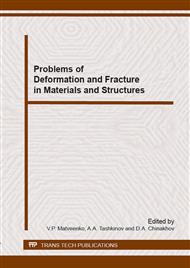[1]
Strulev V.M., Yarkin R.A., Failure mechanism and ways to increase the bearing capacity of bended reinforced concrete elements, Bulletin of TSTU. 6 (2000) 474-477.
Google Scholar
[2]
Ruiz G., Elices M., Planas J., Experimental study of fracture of lightly reinforced concrete beams, Materials and Structures. 31 (1998) 683-691.
DOI: 10.1007/bf02480445
Google Scholar
[3]
Carpinteru A., Carmona J.R., Ventura G., Failure Mode Transitions in Reinforced Concrete Beams – Part 2: Experimental Tests, ACI Structural Journal. 108 (2011) 286-293.
DOI: 10.14359/51682344
Google Scholar
[4]
Bykov A.A., Matveenko V.P., Serivaev G.S., Shardakov I.N., Shestakov A.P., Mathematical modeling of vibrational processes in reinforced concrete structures to manage crack nucleation monitoring, Solid mechanics. 2 (2015) 60-72.
DOI: 10.3103/s0025654415020053
Google Scholar
[5]
Kachlakev D., Miller T.F.E., Modeling of Reinforced Concrete Structures Strengthened with FRP Laminates, Final Report, Oregon Department of Transportation, (2001).
Google Scholar
[6]
Rashid Y.R., Analysis of Prestressed Concrete Pressure Vessels, Nuclear Engineering and Design, 7 (1968) 334-344.
DOI: 10.1016/0029-5493(68)90066-6
Google Scholar
[7]
Kwak H.G., Flippou C.F., Finite Element Analysis of reinforced concrete structures under monotonic loads, Report, University of California, Berkley, (1990).
Google Scholar
[8]
Dahmani L., Khennane A., Kaci S., Crack Identification in Reinforced Concrete Beams Using ANSYS Software, Strength of Materials. 2 (2010) 141-153.
DOI: 10.1007/s11223-010-9212-6
Google Scholar
[9]
Wolansky A.J., Flexural Behavior of Reinforced and Prestressed Concrete Beams Using Finite Element Analysis, Thesis, Marquette University, Milwaukee, (2004).
Google Scholar
[10]
Barbosa A.F., Ribeiro G.O., Analysis Of Reinforced Concrete Structures Using Ansys Nonlinear Concrete Model, Comp. Mechanics New Trends and Applications, Barcelona, (1998).
Google Scholar
[11]
Dawari V.B., Vesmawala G.R., Application of Nonlinear Concrete Model for Finite Element Analysis of Reinforced Concrete Beams, International Journal of Scientific and Engineering Research. 5 (2014) 776-782.
Google Scholar
[12]
Rasmussen A.B., Analytical and Numerical Modeling of Reinforced Concrete in Serviceability Limit State, Thesis, Aarhus University, (2012).
Google Scholar
[13]
Lur'e A. I, Theory of Elasticity, Nauka, Moscow, (1970).
Google Scholar
[14]
William K.J., Warnke E.P., Constitutive Model for the Triaxial Behavior of Concrete, Proceedings of International Association of Bridge Structural Engineering. 19 (1974) 1-30.
Google Scholar
[15]
Novatsky V., The Theory of elasticity, Mir, Moscow, (1975).
Google Scholar
[16]
Malinin N.N., Applied theory of plasticity and creeping, second ed., Mashinostroyenie, Moscow, (1975).
Google Scholar
[17]
Bathe K.J., Finite Element Procedures, Prentice-Hall, Englewood Cliffs. (1996).
Google Scholar


